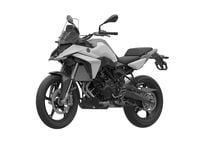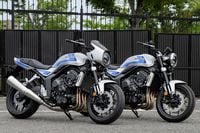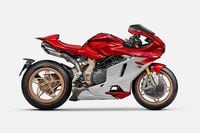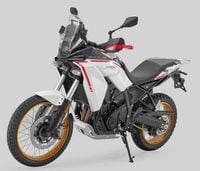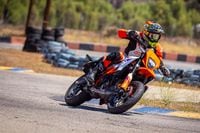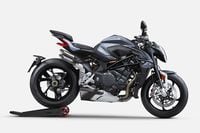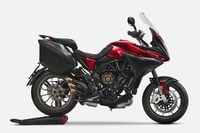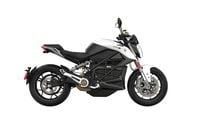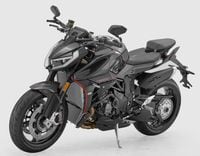Among the many unique segments found within motorcycling today, sport-touring just flat out (no pun intended) makes sense. That’s because the sport-touring design paradigm of being fast, great handling, comfortable, and long-legged—with pack-mule-like cargo capacity—perfectly feeds many riders’ need for speed and travel. Want to blaze across eastern Colorado and then assault the Rockies, head from Seattle down to Laguna Seca, or dispatch the Blue Ridge Parkway on the way to Biloxi? A sport-tourer does the trick. Generally, we’d consider 900cc to 1300cc as the preferred displacement for a great sport-tourer, but exceptions do exist. Read on for a dozen strong choices between 745cc and 1301cc—plus one electric bike.
Based on BMW’s S 1000 RR superbike, winner of the 2024 World Superbike championship with Toprak Razgatlıoğlu, the S 1000 XR melds superlative performance with touring accoutrements to create a highly effective sport-tourer. Beneath the rakish bodywork is a DOHC inline-four displacing 999cc and producing a claimed 170 hp at a scintillating (i.e., quite busy!) 11,000 rpm. If that sounds like pure chaos for a touring rig, the S 1000 XR motor is also tuned to deliver good midrange, and its six-speed gearbox adds flexibility for the varying conditions touring can present. An aluminum frame and swingarm, auto-adjusting fork and shock (Dynamic ESA in BMW parlance), and multiple ride modes ensure a great, well, ride. For 2025, the base MSRP is $17,995, with options ranging from designer wheels to an M Package inspired by BMW’s auto division starting in 1978.
Few may believe it, but Ducati‘s first V-twin model a half-century ago was actually a “grand touring” bike called the 750 GT, a torquey roadster that excelled at fast, long-distance travel. The 2025 SuperSport 950 continues this approach in an appealing manner. Employing a steel trellis frame—early Ducati V-twin frames likewise used steel tubes—the SuperSport 950 packs 937cc of Testastretta 11º desmodromic V-twin producing a claimed 110 hp and featuring an 18,000-mile valve clearance service interval. A boatload of worthy features for the $15,495 SuperSport 950 includes a quickshifter, slipper clutch, tunable Marzocchi fork and Sachs shock, 17-inch Pirelli Diablo Rosso III tires, and rider aids including multiple power modes, traction and wheelie control, and Bosch cornering ABS. Priced at $18,395, a SuperSport 950 S version adds fully adjustable Öhlins suspension.
Ducati’s Multistrada has evolved over the years, but in its latest form it is perhaps one of the most versatile streetbikes on the market. Of course, it’s not afraid of a little dirt here and there, but this 17-inch wheeled base model and the three up-tier models most closely related to it, the V4 S, V4 RS, and V4 Pikes Peak, are asphalt-oriented machines. All are powered by the 1158cc V-4 Granturismo engine, with only the RS featuring a different state of tune. The standard model comes with manually adjustable suspension and less-sophisticated electronics features, while the $27,195 S gets Skyhook electronic suspension, and radar-enabled cruise control. Want the spiciest Multistrada? Opt for the $37,995 RS, with 180 hp (compared to 170), a dry clutch, forged Marchisini wheels and all of the electronic gizmos. The $31,995 Pikes Peak sits in between the S and RS and comes with much of the latter’s upscale chassis features and special livery. Last but not least, if you want to explore a bit more dirt the $30,595 V4 Rally is equipped with wire-spoke wheels in 19-inch front and 17-inch rear, with equipment better suited to a bit of off-highway exploration.
Honda‘s innovative and practical sides merge in the NC750X DCT. The innovation comes from the dual-clutch transmission (DCT) integrated with the 745cc liquid-cooled parallel-twin engine. There’s no clutch lever and the DCT handles all such activities to allow remarkably seamless shifts. Operationally, the rider has two primary choices: 1) In drive or sport mode, let the gearbox handle all upshifting and downshifting; or 2) Manually shift the gearbox using toggles on the left side of the handlebar. The NC750X DCT‘s practical side is illustrated by the voluminous (23 liters) lockable storage area under the faux gas-tank cover (gas is carried in a 3.8-gallon tank located under the seat), plenty to store for a full-face helmet or grocery shopping. Further illustrating Honda’s practical side, for 2025 the NC750X DCT is priced at just $9499.
Take the powertrain that we love from Honda‘s Africa Twin and apply it to an upright, comfortable, and modern sport-tourer and you end up with the NT1100. This motorcycle is all new for the 2025 model year, and is powered by the liquid-cooled 1084cc parallel-twin front the aforementioned adventure bike. The engine features a single overhead cam design, with four valves per cylinder, and is fed by Programmed Fuel injection (PGM-FI). The crankpins are set at 270 degrees for smooth power and torque delivery. The NT1100 comes standard with a six-speed dual-clutch transmission (DCT). The chassis is all new and unique to the NT1100. Long-travel Showa suspension is used front and rear with 5.9 inches of travel at each end. A pair of radial-mount four-piston calipers and 310mm discs with standard ABS are used at the front. Cast aluminum wheels in 17-inch diameters are used front and rear and mounted with sport-oriented rubber. Optional saddlebags have a combined 73 liters of capacity, while touring amenities like heated grips, an adjustable windscreen, and touring seat should make long miles in the saddle enjoyable.
To achieve sport-touring nirvana, the Ninja 1100SX SE ABS eschews some of the hard-hitting technology of the Ninja ZX-10R in favor of upright and friendly ergonomics, viable seating for two (with passenger grips), and an adjustable windscreen. The 1100 model gets a new 1099cc inline-four engine with a focus on low- to midrange power output. Output is a claimed 134 hp at 9000 rpm with 83.2 lb.-ft. of peak torque at 7600 rpm. A new Kawasaki Quick Shifter has been optimized for low-rpm performance. The Ninja SX SE comes equipped with a full suite of electronic rider aids including lean-sensitive traction control and ABS, and power modes. It wouldn’t be a sport-tourer without a luggage option, and the 28-liter color-matched sidecase can be ordered as an accessory for $823, are waterproof and keyed to the ignition key for convenience. Other features standard on the SE model (compared to the base SX) include an Öhlins S46 rear shock, Brembo front calipers and stainless steel brake lines, and heated grips.
High on the audacious scale and priced at a lofty $29,100, the H2 SX SE is the sport-touring version of Kawasaki‘s mind-bending 190 hp H2. Featuring a supercharged and intercooled 998cc DOHC inline-four engine wrapped inside a steel trellis frame, the SX SE marries truly extreme performance with more comfortable ergonomics. Especially when outfitted with Kawasaki’s 28-liter accessory side cases—priced at $823, they’re color-matched for a perfect look—the irreproachable power of the H2 SX gains the carrying capacity of a sport-tourer. So outfitted, it’s perfect for long-distance, low-altitude strafing of locations from Death Valley to Denali, and from Nova Scotia to Nashville. En route, riders will appreciate numerous onboard electronic functions, a few of which include traction and wheelie control, cornering ABS, selectable power modes, electronic cruise control, Auto Hi-Beam sensor, Tire Pressure Monitoring System (TPMS), Vehicle Hold Assist (VHA), KIPASS remote key fob, and smartphone connectivity.
When the first single-cylinder Duke launched in the mid-1990s, KTM started a high-performance naked-bike (some might say hooligan) trend that’s just gotten better and better over time. Fast forward to 2024, and the 1290 Super Duke GT gentrifies the extreme performance of the 1290 Super Duke with “grand touring” (hence the GT moniker) components. These include a rakish fairing for wind and weather protection (a nine-way-adjustable windscreen that helps fine-tune the aero for your size, speed, and weather), electronically adjustable suspension, and an enlarged 6.1-gallon fuel tank for extended touring stints. Underneath lives and breathes the Super Duke’s signature element, its narrow and nasty 1301cc LC8 V-twin, now meeting cleaner EPA emissions specs. Unquestionably, the KTM 1290 Super Duke is a performance standout, and the added touring capability makes the GT version a viable choice for performance-driven riders who want to stretch their horizons. We have confirmed that the model will get the larger updated engine soon and become the 1390 Super Duke GT for 2025.
With the switchbacks of the Italian Alps so close to Moto Guzzi‘s hometown, it’s little wonder the storied bike company offers an energetic sport-tourer. Or make that three sport-tourers, counting the base V100 Mandello ($15,490), the limited-edition V100 Mandello Aviazione Navale ($16,990), and the upscale V100 Mandello S ($17,490). Central to all three models is Moto Guzzi’s new 1042cc 115-hp (claimed) liquid-cooled V-twin. Like all contemporary Guzzis, it’s mounted longitudinally in the frame, and sends power to the rear wheel through a six-speed gearbox and shaft drive. Touring niceties include an electrically adjustable windscreen atop a bright LED headlight, the first use of speed-adaptive aero wings on the fairing, and electronic aids such as selectable ride modes, cornering ABS, traction control, and cruise control. The specially finished, limited-production V100 Mandello Aviazione Navale takes inspiration from the F-35B fighter and wears a laser-etched serial number. Stepping up to the V100 Mandello S brings trick Öhlins semi-active suspension, which allows dialing in ride and handling on the fly.
Like so many other classes of motorcycles, sport-touring is fragmented into a variety of design philosophies. The RS is actually most closely related to the also-new R 1300 R roadster, which differs in many ways from the RT above. But at its core, it is powered by the same brand-new 145-hp 1300cc boxer twin that powers the GS, GS A, RT, and R models. BMW’s brand-new ASA automated manual transmission can be added as an option. For 2026, the RS has been altered to be sportier than ever before with lower handlebars, more rearset footpegs and added cornering clearance.
Like all of the new boxer models, the RS uses the engine as a stressed member inside of a steel-sheet monocoque frame with a bolt-on aluminum subframe. Like the R model and unlike the others in the boxer range, the RS uses a conventional inverted 47mm telescopic fork instead of a Telelever system. The suspension is managed by BMW’s semi-active Dynamic ESA system and can be upgraded to the latest Dynamic Suspension Adjustment (DSA) system, which introduces the ability to electronically change the spring rates front and rear as well as the damping.
Like all of the R 1300 models, the RS has a complete suite of advanced rider aids, with some optional choices to further enhance the technology. A variety of luggage choices are available as options, and multiple option packages can be selected that are tied to each bike’s paint schemes.
Related: Built for Comfort. Built for Speed
Known for its high-style, high-performance sportbikes, MV has imbued the Turismo Veloce (translation: “touring speed”) with suitable go-fast features and, in doing so, describes it as “Racing DNA on Tour.” The heart of the Turismo Veloce is a 798cc 110-hp inline-triple that hangs from a steel trellis frame and is backed by a single-sided aluminum swingarm that, in turn, is flanked by a wild three-outlet exhaust system. The entire affair is cloaked in super-edgy bodywork designed for decidedly sporty touring. Basically, you might regard the Turismo Veloce as a hypermotard touring rig. Useful touring features include a tall handlebar, an even taller windscreen, and large side cases. Among various Turismo Veloce models offered by the storied Italian racing company are the comfort-oriented Lusso SCS ($25,598 MSRP) and the racy Turismo Veloce RC SCS ($27,998).
A distant relative of the all-conquering GSX-R1000R superbike, the GSX-S1000GT+ softens the outright maniacal character of Suzuki‘s racing lineage and adds touring capability. Carrying an MSRP of $14,299 for 2025, the GSX-S1000GT weds a liquid-cooled 999cc DOHC inline-four with ride-by-wire throttle control and a six-speed gearbox to a proven aluminum twin-spar frame. From here, Suzuki integrated a large fairing and windscreen, comfortable seating ergonomics (including a tall handlebar setup), and multiple selectable ride modes and traction control settings, plus a quickshifter. Twin LED headlights are a huge asset as night falls while you’re in deer and elk country. The color-matched and lockable sidecases come standard. The GT+ is available in two color options for 2025: Pearl Vigor Blue or Metallic Oort Gray No.3.
Despite its adventure-bike styling, there is no question that Triumph’s brand-new Tiger Sport 800 is an asphalt-oriented crossover. The formula is to provide upright adventure-bike comfort with sportbike-like handling, which by our definition is the template for a sport-touring machine. One of the keys to its personality is the 17-inch wheel and tire package front and rear with sport-oriented rubber. Power comes from a new 798cc inline-triple making a claimed 113 hp and 70 lb.-ft. of peak torque, which is a big bump over the 850 Sport’s output. Adjustable Showa suspension at each end provides 5.9 inches of travel, while a pair of four-piston radial-mount calipers and 310mm discs provide sporty brake performance. The electronics package includes a trio of ride modes including: Sport, Road, and Rain, with no attempt to provide an off-highway enduro mode. Other standard electronic features include lean-sensitive traction control and ABS, the Shift Assist quickshifter, and cruise control. Tick the $1156 GT Pack in the accessory options and you get sidecase, heated grips, and hand guards.
If there is a bike that defines the sport-touring class, it has to be BMW’s RT. The bike can be traced back to the late 1980s and the R100RT (Reise-Tourer), but the lineage from the mid-’90s, when the R1100RT first got oil-cooled heads, until now has been a gradual evolution of the boxer-twin engine that has always powered the model and changing technology. This latest R 1300 RT model receives the 1300cc unit that first found a home in the 2024 R 1300 GS, and then a year later the R 1300 GS Adventure. This engine is a clean-sheet redesign, with the transmission moved under the engine for a more compact layout (shorter), ShiftCam variable valve timing, and a claimed 145 hp and 110 lb.-ft. of peak torque. As on the other R 1300 models, the RT can be outfitted with the new ASA automated manual transmission.
Like the pair of GS models that preceded it, the RT gets the steel-sheet main frame that utilizes the engine as part of the structure, and then an aluminum subframe that bolts on. As before, the RT uses the latest (heavily revised) version of the Telelever front end and paralever swingarm/shaft drive unit. That suspension features either BMW’s Dynamic ESA electronic suspension, or the optional Dynamic Chassis Adaption (DCA) system.
The RT is loaded with technology with advanced rider aids and radar-enabled safety features like Active Cruise Control (ACC), Front Collision Warning (FCW), Rear End Collision Warning (RECW), and Lane Change Warning (LCW) systems. All electronic features are now accessed by a huge 10.25-inch TFT dash, with built-in map-based navigation and a “connectivity hub” to help control accessories from your phone and the audio system. Standard 27-liter sidecases can be upgraded to BMW’s Vario case that can expand to 33 liters, and a pair of top cases are available as options.










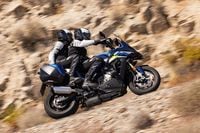
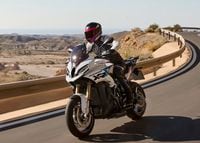
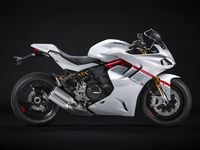
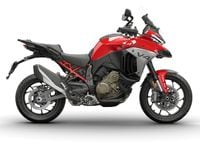
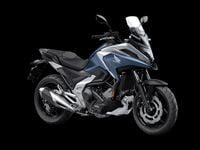
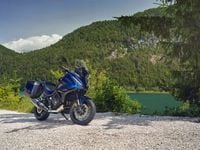
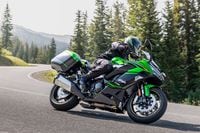
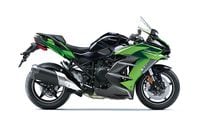
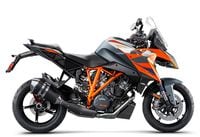
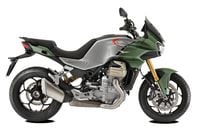
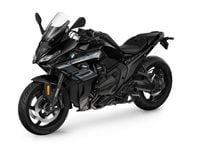
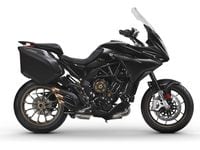
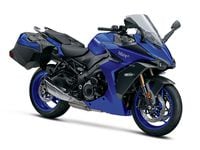
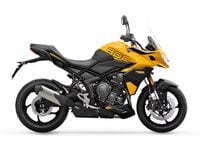
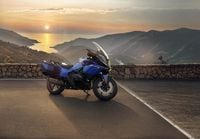
/cloudfront-us-east-1.images.arcpublishing.com/octane/6JPU4U2H7GOYZH2ZETYQBFLR2Q.jpg)
/cloudfront-us-east-1.images.arcpublishing.com/octane/CXNPUJDPPBCVHIRI5H7UOCX5HY.jpg)
/cloudfront-us-east-1.images.arcpublishing.com/octane/RZ5QNVGN4ZDRHJIKTPHGDX3HKA.jpg)
/cloudfront-us-east-1.images.arcpublishing.com/octane/ZGBASNGFXVBGXAQGDM6EWLNFXA.jpg)
/cloudfront-us-east-1.images.arcpublishing.com/octane/54BEFUE3XBDCTCAYUYQNZGAJV4.jpg)
/cloudfront-us-east-1.images.arcpublishing.com/octane/5XF2ZKSOR5G7TO23KSYT4JADTU.jpg)
/cloudfront-us-east-1.images.arcpublishing.com/octane/VHUK3FH6WFHLTHN7CKCATU36LM.jpg)
/cloudfront-us-east-1.images.arcpublishing.com/octane/HC4P3CYOXFF3NGXCQTGORFRYNY.jpg)
/cloudfront-us-east-1.images.arcpublishing.com/octane/ZNANUJGGKVBIFH3VRZ32BYC454.jpg)
/cloudfront-us-east-1.images.arcpublishing.com/octane/JACAJ4MPKJBTDBOZRTHXZAKLTA.jpg)
/cloudfront-us-east-1.images.arcpublishing.com/octane/7L3YWQXRBRECXMWQ6NBVAHU2EY.jpg)
/cloudfront-us-east-1.images.arcpublishing.com/octane/BPD5CKH5IFGDLG67Y24UMOXXGA.jpg)
/cloudfront-us-east-1.images.arcpublishing.com/octane/CHQ32B6TVBEPVFNPERY3AB2H3M.jpg)
